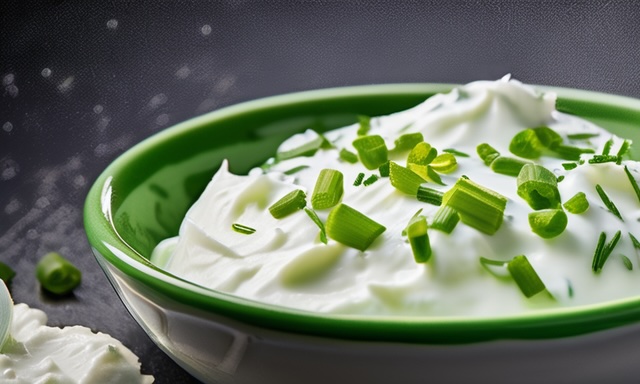Internet Asks: "Sour Cream vs Greek Yogurt"
In the realm of creamy, tangy dairy products, sour cream and Greek yogurt hold prominent spots. Both are beloved for their versatility in the kitchen, finding their place in everything from dips to baked goods. However, despite their similar uses, sour cream and Greek yogurt have distinct characteristics, nutritional profiles, and culinary impacts. This article delves into the differences and similarities between the two, offering insights into when and why you might choose one over the other.
sponsored links

Origins and Production
Sour Cream is a fermented dairy product made by adding lactic acid bacteria to cream, which thickens the cream and gives it a tangy flavor. The fat content in sour cream typically ranges from 18% to 20%, classifying it as a high-fat product.
Greek Yogurt, on the other hand, is made by straining regular yogurt to remove the whey, resulting in a thicker, creamier consistency. The straining process concentrates the protein content and reduces the lactose, making Greek yogurt a protein-rich and lower-lactose option compared to traditional yogurt.
Nutritional Differences
One of the most significant distinctions between sour cream and Greek yogurt lies in their nutritional content.
Sour Cream:
- - Calories and Fat: Sour cream is traditionally made from cream and contains higher amounts of calories and saturated fats. A typical serving of sour cream can contain around 5 grams of fat and 60 calories.
- - Protein and Probiotics: It has a lower protein content compared to Greek yogurt and lacks the probiotics found in fermented dairy products.
Greek Yogurt:
- - Protein: Greek yogurt is renowned for its high protein content, with about 10 grams of protein per 100 grams, supporting muscle repair and growth.
- - Probiotics: It is rich in probiotics, beneficial for gut health.
- - Calories and Fat: Greek yogurt comes in full-fat, low-fat, and fat-free varieties, offering options with fewer calories and less saturated fat compared to sour cream.
Flavor and Texture
While both sour cream and Greek yogurt are creamy and tangy, there are subtle differences in their flavor profiles and textures that might influence their use in recipes:
Sour Cream: Has a rich, velvety texture with a mild tanginess. Its high fat content gives it a luxurious mouthfeel, making it a popular topping for baked potatoes, soups, and Mexican dishes.
Greek Yogurt: Offers a sharper tang and a thicker consistency than sour cream. Its creamy yet firm texture makes it versatile in both savory and sweet dishes, from dips and dressings to smoothies and desserts.
Culinary Uses
Both sour cream and Greek yogurt can often be used interchangeably in recipes, depending on personal preference and desired nutritional content. However, their distinct flavors and textures might make one more suitable than the other in certain dishes:
- Sour Cream: Ideal for adding richness and a smooth texture to sauces, baked goods, and toppings. Its higher fat content can provide a more indulgent taste to dishes.
- Greek Yogurt: A healthier alternative for adding creaminess to recipes, Greek yogurt works well in smoothies, marinades, baking, and as a base for dips and spreads. Its higher protein content and lower fat levels make it a popular choice for those looking for a nutritious option.
sponsored links
Health Implications
Sour Cream
Due to its high saturated fat content, sour cream should be consumed in moderation, particularly for individuals watching their fat intake or those with heart health concerns. Light and fat-free versions are available for a healthier option, though they may contain additives to mimic the texture of full-fat sour cream.
Greek Yogurt
Greek yogurt is often touted as a superfood due to its probiotic content, which supports gut health, and its high protein levels, which can aid in muscle repair and satiety. The calcium and vitamin B12 in Greek yogurt also contribute to bone health and energy metabolism, respectively. Choosing low-fat or fat-free versions can provide the health benefits with fewer calories and less saturated fat.
Conclusion
sponsored links
References
1. USDA FoodData Central. Sour cream, regular. https://fdc.nal.usda.gov/fdc-app.html#/food-details/1097906/nutrients.
2. MasterClass. How to Make Sour Cream: Easy Homemade Sour Cream Recipe. https://www.masterclass.com/articles/how-to-make-sour-cream.
3. AMS Nutrition Counseling. Healthier Swaps: Greek Yogurt for Sour Cream. https://www.amsnutritioncounseling.com/post/healthier-swaps-greek-yogurt-for-sour-cream
4. Undeniably Dairy. Greek Yogurt As A Substitute For Common Ingredients. https://www.usdairy.com/news-articles/how-to-substitute-greek-yogurt-into-recipes
5. USDA FoodData Central. Yogurt, Greek, plain, nonfat (Includes foods for USDA's Food Distribution Program). https://fdc.nal.usda.gov/fdc-app.html#/food-details/170894/nutrients
6. Health. Health Benefits of Greek Yogurt. https://www.health.com/greek-yogurt-benefits-7852584
7. American Dairy Association. Sour Cream. https://www.americandairy.com/health-wellness/benefits-of-dairy/sour-cream/
People are also reading...
Calories in Cup of Sugar
Calories in Brown Sugar
Greek Yogurt Sour Cream
How Long Can Greek Yogurt Sit Out?
Kirkland Greek Yogurt Nutrition
How Long is Greek Yogurt Good for After Opening?
See the answer to: "How Long is Greek Yogurt Good for After Opening?"
How Long is Greek Yogurt Good for?
What Does Greek Yogurt Taste Like?
Can Greek Yogurt Go Bad?
Ready to level-up?
Create meal plans 10x faster, follow up with your clients through our mobile app, and never struggle with meal planning or recipe management again.